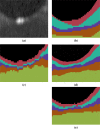Multiple-object geometric deformable model for segmentation of macular OCT
- PMID: 24761289
- PMCID: PMC3986003
- DOI: 10.1364/BOE.5.001062
Multiple-object geometric deformable model for segmentation of macular OCT
Abstract
Optical coherence tomography (OCT) is the de facto standard imaging modality for ophthalmological assessment of retinal eye disease, and is of increasing importance in the study of neurological disorders. Quantification of the thicknesses of various retinal layers within the macular cube provides unique diagnostic insights for many diseases, but the capability for automatic segmentation and quantification remains quite limited. While manual segmentation has been used for many scientific studies, it is extremely time consuming and is subject to intra- and inter-rater variation. This paper presents a new computational domain, referred to as flat space, and a segmentation method for specific retinal layers in the macular cube using a recently developed deformable model approach for multiple objects. The framework maintains object relationships and topology while preventing overlaps and gaps. The algorithm segments eight retinal layers over the whole macular cube, where each boundary is defined with subvoxel precision. Evaluation of the method on single-eye OCT scans from 37 subjects, each with manual ground truth, shows improvement over a state-of-the-art method.
Keywords: (100.0100) Image processing; (170.4470) Ophthalmology; (170.4500) Optical coherence tomography.
Figures




Similar articles
-
Layer boundary evolution method for macular OCT layer segmentation.Biomed Opt Express. 2019 Feb 4;10(3):1064-1080. doi: 10.1364/BOE.10.001064. eCollection 2019 Mar 1. Biomed Opt Express. 2019. PMID: 30891330 Free PMC article.
-
Retinal layer segmentation of macular OCT images using boundary classification.Biomed Opt Express. 2013 Jun 14;4(7):1133-52. doi: 10.1364/BOE.4.001133. Print 2013 Jul 1. Biomed Opt Express. 2013. PMID: 23847738 Free PMC article.
-
Comparison of point estimates and average thicknesses of retinal layers measured using manual optical coherence tomography segmentation for quantification of retinal neurodegeneration in multiple sclerosis.Curr Eye Res. 2013 Jan;38(1):224-8. doi: 10.3109/02713683.2012.722243. Epub 2012 Sep 6. Curr Eye Res. 2013. PMID: 22954302 Free PMC article.
-
Automatic Anisotropic Diffusion Filtering and Graph-search Segmentation of Macular Spectral-domain Optical Coherence Tomographic (SD-OCT) Images.Curr Med Imaging Rev. 2019;15(3):308-318. doi: 10.2174/1573405613666171201155119. Curr Med Imaging Rev. 2019. PMID: 31989882 Review.
-
A review of algorithms for segmentation of optical coherence tomography from retina.J Med Signals Sens. 2013 Jan;3(1):45-60. J Med Signals Sens. 2013. PMID: 24083137 Free PMC article. Review.
Cited by
-
Layer boundary evolution method for macular OCT layer segmentation.Biomed Opt Express. 2019 Feb 4;10(3):1064-1080. doi: 10.1364/BOE.10.001064. eCollection 2019 Mar 1. Biomed Opt Express. 2019. PMID: 30891330 Free PMC article.
-
Retinal layer parcellation of optical coherence tomography images: Data resource for multiple sclerosis and healthy controls.Data Brief. 2018 Dec 28;22:601-604. doi: 10.1016/j.dib.2018.12.073. eCollection 2019 Feb. Data Brief. 2018. PMID: 30671506 Free PMC article.
-
Inter-scanner Variation Independent Descriptors for Constrained Diffeomorphic Demons Registration of Retina OCT.Proc SPIE Int Soc Opt Eng. 2018 Feb;10574:105741B. doi: 10.1117/12.2293790. Epub 2018 Mar 2. Proc SPIE Int Soc Opt Eng. 2018. PMID: 31695241 Free PMC article.
-
Evaluating White Matter Lesion Segmentations with Refined Sørensen-Dice Analysis.Sci Rep. 2020 May 19;10(1):8242. doi: 10.1038/s41598-020-64803-w. Sci Rep. 2020. PMID: 32427874 Free PMC article.
-
Robust segmentation of retinal layers in optical coherence tomography images based on a multistage active contour model.Heliyon. 2019 Feb 28;5(2):e01271. doi: 10.1016/j.heliyon.2019.e01271. eCollection 2019 Feb. Heliyon. 2019. PMID: 30891515 Free PMC article.
References
-
- Gordon-Lipkin E., Chodkowski B., Reich D. S., Smith S. A., Pulicken M., Balcer L. J., Frohman E. M., Cutter G., Calabresi P. A., “Retinal nerve fiber layer is associated with brain atrophy in multiple sclerosis,” Neurology 69, 1603–1609 (2007).10.1212/01.wnl.0000295995.46586.ae - DOI - PubMed
-
- Saidha S., Syc S. B., Ibrahim M. A., Eckstein C., Warner C. V., Farrell S. K., Oakley J. D., Durbin M. K., Meyer S. A., Balcer L. J., Frohman E. M., Rosenzweig J. M., Newsome S. D., Ratchford J. N., Nguyen Q. D., Calabresi P. A., “Primary retinal pathology in multiple sclerosis as detected by optical coherence tomography,” Brain 134, 518–533 (2011).10.1093/brain/awq346 - DOI - PubMed
-
- Saidha S., Sotirchos E. S., Ibrahim M. A., Crainiceanu C. M., Gelfand J. M., Sepah Y. J., Ratchford J. N., Oh J., Seigo M. A., Newsome S. D., Balcer L. J., Frohman E. M., Green A. J., Nguyen Q. D., Calabresi P. A., “Microcystic macular oedema, thickness of the inner nuclear layer of the retina, and disease characteristics in multiple sclerosis: a retrospective study,” The Lancet Neurology 11, 963–972 (2012).10.1016/S1474-4422(12)70213-2 - DOI - PMC - PubMed
-
- Saidha S., Syc S. B., Durbin M. K., Eckstein C., Oakley J. D., Meyer S. A., Conger A., Frohman T. C., Newsome S., Ratchford J. N., Frohman E. M., Calabresi P. A., “Visual dysfunction in multiple sclerosis correlates better with optical coherence tomography derived estimates of macular ganglion cell layer thickness than peripapillary retinal nerve fiber layer thickness,” Mult. Scler. 17, 1449–1463 (2011).10.1177/1352458511418630 - DOI - PubMed
Grants and funding
LinkOut - more resources
Full Text Sources
Other Literature Sources
